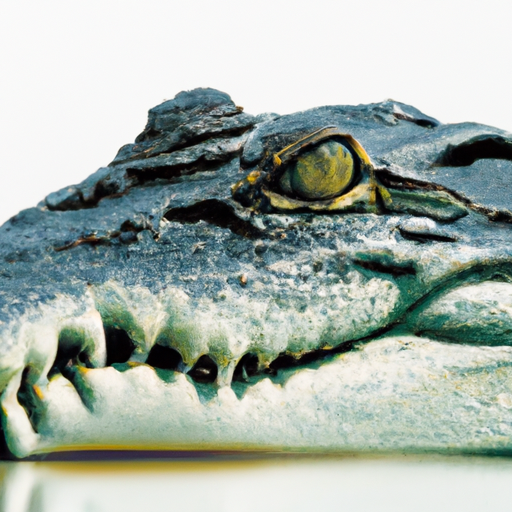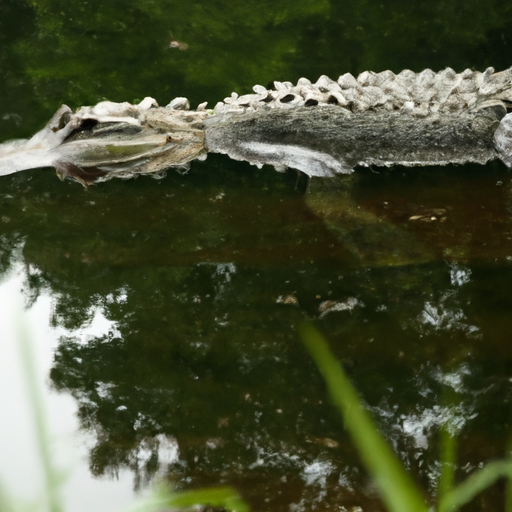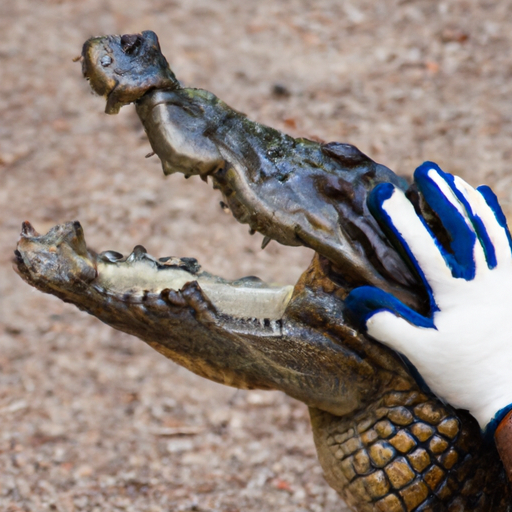Did you know that alligators have not one, not two, but three eyelids? That’s right, these fascinating creatures possess a nifty protective mechanism that sets them apart from other reptiles.
While most animals only have an upper and lower eyelid, alligators have an additional transparent third eyelid called a nictitating membrane.
This extra layer of defense allows them to see underwater without damaging their eyes. So, the next time you come across an alligator, remember, they’re not just another pair of eyes staring back at you – they’ve got a secret weapon protecting their vision.
Anatomy of an Alligator
Alligators are fascinating creatures with a unique set of features that enable them to thrive in their aquatic habitats. As we delve into the anatomy of an alligator, we will explore various aspects such as their body structure, the intricate details of their eyes, and the functions and adaptations of their eyelids.
Body Structure
Alligators have a robust and streamlined body structure that is well-suited for their aquatic lifestyle. These reptiles typically have a long and muscular body, with a strong tail that aids in swimming and propelling through the water. Their limbs are short but powerful, allowing them to maneuver effortlessly both on land and in water.
Skin
One of the most distinctive features of alligators is their skin, which is covered in tough, armored scales known as scutes. These scutes provide both protection and flexibility, enabling alligators to move with agility while also safeguarding them from potential predators or prey. The skin of an alligator is also adorned with prominent ridges called osteoderms, which serve to further fortify its protective shield.
Eyes
The eyes of an alligator are truly captivating. Positioned on the top of its head, these large and rounded eyes give alligators a unique vantage point, allowing them to spot potential prey or threats from a considerable distance. Alligators have excellent eyesight, which is crucial for their survival in their often murky and dimly lit environments.
Eyelids
Just like humans, alligators have both upper and lower eyelids. However, their eyelids possess some interesting characteristics that set them apart from our own. Alligators have a double set of eyelids, with an upper and lower lid to each eye. Additionally, they have a third translucent eyelid called the nictitating membrane, which serves a vital role in protecting and maintaining their vision.
Alligator Eyes
The evolution of alligator eyes has resulted in remarkable adaptations that enhance their visual capabilities, enabling them to thrive in their habitats.
Evolutionary Adaptation
Over millions of years, alligators have evolved to possess eyes that are perfectly adapted to their environment. Their ancestors were land-dwelling reptiles, and as they transitioned to an aquatic lifestyle, their eyes underwent various changes to improve underwater vision. Today, alligator eyes are adept at capturing both light and movement, allowing them to effectively hunt in their watery realm.
Eyeball
The alligator’s eyeball is spherical in shape and slightly flattened at the front, enabling the refraction of light to form clear images. Their eyes are positioned on the top of their heads, enabling them to see above the water while the rest of their body remains submerged. This positioning also allows them to keep an eye out for potential threats or prey while remaining relatively undetectable.
Pupil
The pupils of alligators are vertically oriented, which helps them adapt to different lighting conditions. These vertically slit-shaped pupils allow them to have greater control over the amount of light entering their eyes. By constricting or dilating their pupils, alligators can effectively regulate the amount of light entering their eyes, enhancing their ability to see in both bright and dimly lit environments.
Vision
Alligators have excellent vision, which is vital for their survival. Their eyes are equipped with a high number of light-sensitive cells called cones, enabling them to perceive a broad range of colors. This exceptional color vision aids in identifying prey camouflaged in their surroundings and allows them to navigate their environment with precision.

Understanding Eyelids
While we often take our own eyelids for granted, they play a crucial role in maintaining the health and function of our eyes. The same holds true for alligators, whose eyelids serve vital purposes beyond simply blinking.
Function of Eyelids
The primary function of eyelids, whether in humans or alligators, is to protect the eyes from injury, debris, or excessive light. Eyelids act as a barrier, shielding the delicate structures of the eye and preventing foreign particles from entering. In addition to their protective role, eyelids also aid in the distribution of tears and the removal of debris, ensuring the eyes remain clear and well-moisturized.
Protection
Alligator eyelids are essential for safeguarding their eyes from potential harm. Whether it’s during hunting or defending against preying rivals, alligators face numerous risks that could potentially damage their eyes. The firm closure of their eyelids acts as a barrier, preventing any external objects from coming into direct contact with their eyes.
Moisture Retention
Maintaining moisture within the eyes is crucial for alligators, particularly when submerged underwater for extended periods. The eyelids assist in retaining the natural tear film, preventing excessive evaporation and ensuring that the eyes remain hydrated. Without this moisture retention, alligators would be susceptible to dry eyes, which could lead to discomfort, compromised vision, and potential eye health issues.
Clear Vision
Alligator eyelids play a vital role in maintaining clear and unobstructed vision. By acting as a protective shield, they prevent debris from accumulating on the surface of the eye and obstructing the visual pathway. With clear vision, alligators can accurately perceive their surroundings, locate potential prey, and navigate their environment with confidence.
Alligator Eyelids
Alligator eyelids possess unique adaptations that allow them to effectively carry out their protective functions.
Upper Eyelids
Alligators have upper eyelids that are similar to those of humans. These lids are composed of skin and muscle and are responsible for the primary protection of the eye. During moments of rest or when submerged underwater, the upper eyelids close together, providing a shield and preventing any foreign objects from entering the eye.
Lower Eyelids
The lower eyelids of alligators are also comprised of skin and muscle. They are responsible for additional protection, especially during moments when the alligator surfaces or opens its mouth. The lower eyelids close in coordination with the upper lids to create a comprehensive protective barrier.
Nictitating Membrane
One of the most fascinating features of alligator eyelids is the presence of a nictitating membrane. This translucent and specialized eyelid is positioned in the inner corner of each eye and can be drawn across the surface of the eye when needed. The nictitating membrane acts as a secondary layer of protection and assists in maintaining clear vision underwater.

Unique Eyelid Adaptations
Alligator eyelids possess several adaptations that make them distinct from our own and contribute to their well-being in their natural environment.
Double Set of Eyelids
Alligators have a double set of eyelids, which distinguishes them from many other animals. This additional layer of protection helps prevent dust particles, debris, or water from reaching their eyes. The presence of both upper and lower eyelids provides comprehensive coverage, ensuring the safety of their vision.
Transparent Membrane
The nictitating membrane, also known as the third eyelid, is a unique adaptation found in alligators. This flexible and transparent membrane contributes to the protection and overall health of their eyes. It acts as an additional barrier against foreign objects, but unlike the upper and lower lids, it allows some light to pass through, enabling alligators to maintain visual awareness even when the membrane is across their eyes.
Controlled Movement
Unlike human eyelids that move relatively quickly, alligator lids open and close at a slower pace. This controlled movement allows for precise regulation of light entering the eye, further enhancing their visual capabilities in various environments. By adjusting the speed and rhythm of their eyelid movement, alligators can optimize their vision for hunting, defense, or simply adjusting to changing lighting conditions.
Nictitating Membrane Function
The nictitating membrane serves multiple functions. In addition to providing an extra layer of protection, it also aids in keeping the eye moist and clear from any debris. When submerged underwater, the nictitating membrane effectively redistributes the tear film, ensuring that the eye remains hydrated and allowing for continued visibility. This adaptation is particularly valuable for alligators, as their environment can often be murky or contain debris that may impair their vision.
Comparison to Other Reptiles
While alligators possess unique eyelid adaptations, it is essential to compare these characteristics to other reptiles to gain a broader understanding of their significance.
Crocodiles
Crocodiles, close relatives of alligators, share many similarities in terms of their eye anatomy and eyelid structure. Both crocodiles and alligators have a double set of eyelids and possess a nictitating membrane. These shared features are a testament to their shared evolutionary history and the benefits they offer in their respective environments.
Turtles
Turtles, on the other hand, have a slightly different eye structure compared to alligators. While they also possess upper and lower eyelids, turtles lack a nictitating membrane. Instead, they have a movable, clear, and protective layer called a “spectacle” that covers and shields their eyes. This adaptation allows turtles to maintain visibility while providing adequate protection.
Snakes
Unlike alligators and turtles, snakes do not possess eyelids in the traditional sense. Instead, they have a clear, scale-like structure known as a “brille” that covers their eyes. The brille serves as a protective outer layer, allowing snakes to retain moisture and protect their eyes without the need for eyelids.
Lizards
Lizards exhibit a range of eyelid characteristics depending on their species. Some lizards, such as geckos, have transparent eyelids that do not close fully, serving more as a protective barrier. Other lizards, like chameleons, possess independently movable and highly specialized eyelids. The diversity in eyelid adaptations among lizards showcases the incredible range and versatility of reptilian eye structures.
Eyelids in Alligator Species
While many of the eyelid characteristics discussed apply to alligators as a whole, it is important to note that different alligator species may exhibit subtle variations in their eyelid anatomy and function.
American Alligator
The American alligator, which is most commonly found in the southeastern region of the United States, possesses the eyelid adaptations discussed earlier. With their double set of eyelids and nictitating membrane, American alligators are well-equipped to thrive in their freshwater habitats.
Chinese Alligator
The Chinese alligator, a critically endangered species, also shares similar eyelid characteristics with the American alligator. They have a double set of eyelids and a translucent nictitating membrane that aids in adapting to their specific environment. The presence of these eye adaptations contributes to their survival in the unique ecosystems they inhabit.
Other Alligator Species
While the American and Chinese alligators are the most well-known species, several other alligator species exist, each with their own distinct eyelid characteristics. While these species may exhibit variations in their eyelids, the underlying functions of protection, moisture retention, and clear vision remain consistent across all alligator species.
Changes with Age
As alligators develop and mature, their eyes and eyelids undergo changes that reflect the stages of their life cycle.
Development of Eyelids
Like many reptiles, alligators experience a gradual development of their eyelids through their embryonic stages. Initially, alligator embryos possess a layer of tissue covering their eyes, which eventually differentiates into the upper and lower eyelids. As the embryos continue to grow, the eyelids become more defined and functional.
Maturing Eyelids
As alligator hatchlings emerge from their eggs, their eyelids are still relatively underdeveloped. However, as they grow, their eyelids mature, becoming stronger and more effective in their protective functions. The maturation of the eyelids allows young alligators to navigate their environment with increasing confidence and assurance.
Eyelid Condition in Adults
In adult alligators, the eyelids continue to play a vital role in protecting the eyes and maintaining clear vision throughout their lives. The constant exposure to their aquatic environment and various external factors necessitates the continued functionality and resilience of their eyelids. While the specific characteristics of adult alligator eyelids may vary slightly from their juvenile counterparts, the fundamental functions and adaptations remain unchanged.
Eyelid-Related Health Issues
While alligator eyelids are remarkable in their capabilities, they are still susceptible to various health issues that can impact their overall eye health and well-being.
Eyelid Infections
Similar to humans, alligators can experience eyelid infections, such as conjunctivitis or blepharitis. These infections can result from bacteria or irritants entering the eye or from improper eyelid hygiene. Prompt veterinary care and appropriate treatment are essential in managing these infections to prevent further complications and discomfort.
Inflammation
Inflammatory conditions affecting the eyelids can occur in alligators, leading to redness, swelling, and discomfort. These conditions can arise due to allergies, physical trauma, or other underlying health concerns. Regular monitoring and prompt veterinary intervention can help mitigate inflammation and prevent potential complications.
Irritation
Alligators’ eyes and eyelids can become irritated due to external factors such as pollutants or debris in their environment. Irritation can result in excessive blinking, redness, or discomfort. Adequate management of their surroundings and prompt veterinary care can alleviate irritation and prevent further damage to the eyes and eyelids.
Eyelid Shedding
As part of their natural growth cycle, alligators periodically shed their skin, including their eyelids. This process ensures the continuous growth and renewal of healthy tissues. Shedding of the eyelids typically occurs without any complications or discomfort. However, if shedding is incomplete or obstructed, it could result in potential vision impairment or other eye health issues. Proper monitoring and appropriate veterinary intervention can help ensure a smooth shedding process.
Conservation Importance
Understanding the significance of alligator eyelids in their survival is crucial for conservation efforts aimed at protecting these remarkable creatures and their delicate ecosystems.
Role of Eyelids in Alligator Survival
Alligator eyelids, with their unique adaptations and functions, play a significant role in the survival of these reptiles. The protection provided by their eyelids allows them to thrive in their natural habitats, effectively hunt for prey, and defend themselves against potential threats. Without the adequate functionality of their eyelids, alligators would be vulnerable to injuries, impaired vision, and potential complications that could jeopardize their survival.
Implications for Conservation
Recognizing the importance of alligator eyelids informs conservation strategies and management plans. Preserving the habitats where alligators reside, maintaining the quality of water sources, and minimizing human interference are essential components in safeguarding these reptiles and their eye health.
Educational Significance
The unique and fascinating eyelid adaptations of alligators offer valuable educational opportunities. Studying the complexities of alligator eyelids not only enhances our understanding of the natural world but also inspires engagement in conservation efforts. By educating the public about the intricate details of alligator anatomy, including their remarkable eyes and eyelids, we can foster a sense of appreciation and respect for these incredible creatures and the ecosystems they inhabit.
Final Thoughts
In conclusion, alligator eyelids represent an extraordinary feat of evolution. Their unique adaptations, including the double set of eyelids and the translucent nictitating membrane, contribute to the alligator’s survival, vision, and overall eye health.
Understanding the anatomy and functions of alligator eyelids not only deepens our knowledge of these remarkable reptiles but also underscores the importance of conservation and the delicate balance required to protect them and their habitats.




